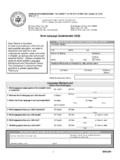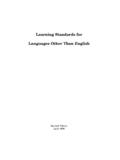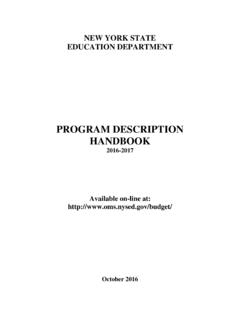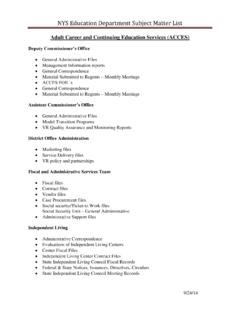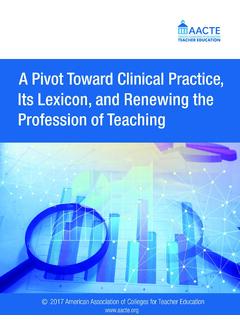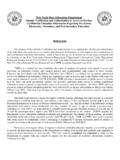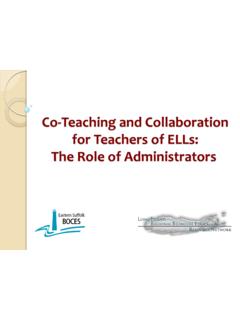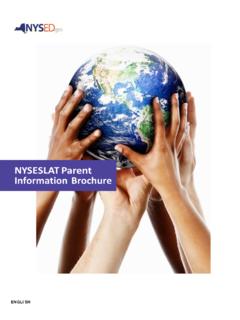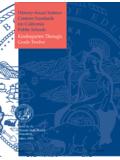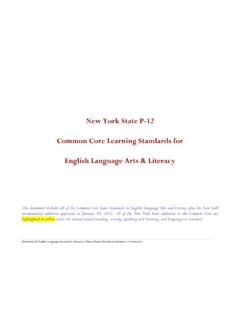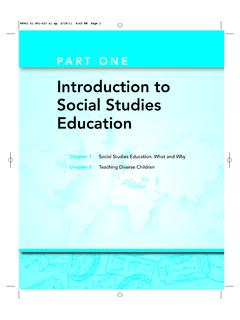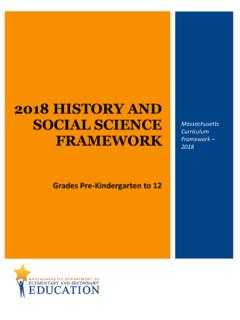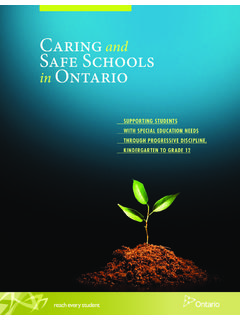Transcription of New York State Common Core Social Studies K-12 Frameworks
1 The State Education Department The University of the State of New York New York State K-12. Social Studies Framework Introduction Revised November 2014. Contents Introduction .. 2. Overview .. 2. New York State Common Core Learning Standards for English Language Arts and Literacy in history / Social Studies , Science, and Technical 4. College and Career Readiness Anchor Standards for Reading .. 4. College and Career Readiness Anchor Standards for Writing .. 5. College and Career Readiness Anchor Standards for Speaking and 5. The C3 Framework and the Inquiry Arc .. 7. Key Components .. 8. Unifying Themes .. 10. Themes at a Glance .. 10. Themes with Context .. 11. Content Sequence .. 12. How to Read the Social Studies Framework .. 13. Vertical Articulation and Progression of Social Studies 14. Reading Standards for Literacy in history / Social Studies 5-12.
2 22. Writing Standards for Literacy in history / Social Studies .. 24. Reference 28. Introduction Page 1. Introduction Social Studies is intended to promote civic competence through the integrated study of the Social sciences and humanities. Within the school program, Social Studies provides coordinated, systematic study that draws upon such disciplines as anthropology, archaeology, economics, geography, history , law, philosophy, political science, psychology, religion, belief systems, and sociology, as well as upon appropriate content from the humanities, mathematics, and natural sciences. The primary purpose of Social Studies is to help young people develop the ability to make informed and reasoned decisions for the public good as citizens of a culturally diverse, democratic society in an interdependent world (adapted from the National Council for the Social Studies [NCSS] definition of Social Studies ).
3 The Social Studies Framework allows for: Students to develop an understanding of concepts and key ideas through inquiry, analysis of primary and secondary source documents, and disciplinary skills and practices. Students to be assessed on their understanding of key ideas and conceptual understandings as well as Social Studies practices. Students to be instructed across the K-12 spectrum by using a cohesive set of themes, key ideas, and concepts. Districts and teachers to continue to have decision-making power about how to teach and illustrate key ideas and conceptual understandings to promote student understanding. Overview New York State K-12 Social Studies Framework ( NYS Framework ) is anchored in the New York State Common Core Standards for Literacy and Writing and New York State Learning Standards for Social Studies . These standards serve as a consistent set of expectations for what students should learn and be able to do, so that we can ensure that every student across New York State is prepared to be an active and engaged citizen who is ready to pursue college or a career.
4 This document fuses the New York State Learning Standards, Key Ideas, and Conceptual Understandings and content sequence into a single document. The course sequence is similar to that of the previous Social Studies Resource Guide with Core Curriculum. Unifying Themes based primarily on the National Council for the Social Studies themes serve to unify ideas and concepts across all grade levels. The Common Core Literacy Skills and Social Studies Practices include the skills and habits of mind that should be developed and fostered, using the content for each grade. Key Ideas and Conceptual Understandings for each grade level with supporting Content Specifications are incorporated. The College, Career and Civic Life Framework, notably the Inquiry Arc, is referenced as a curriculum development resource. Introduction Page 2. New York State Learning Standards for Social Studies The five learning standards, adopted by the Board of Regents in 1996, continue to provide the overall foundation for the NYS Framework.
5 Each Key Idea is derived from and/or aligned to one of these standards as the primary standard. In many cases, a Key Idea represents more than one standard. Standard 1: history of the United States and New York Students will use a variety of intellectual skills to demonstrate their understanding of major ideas, eras, themes, developments, and turning points in the history of the United States and New York. Standard 2: World history Students will use a variety of intellectual skills to demonstrate their understanding of major ideas, eras, themes, developments, and turning points in world history and examine the broad sweep of history from a variety of perspectives. Standard 3: Geography Students will use a variety of intellectual skills to demonstrate their understanding of the geography of the interdependent world in which we live local, national, and global including the distribution of people, places, and environments over Earth's surface.
6 Standard 4: Economics Students will use a variety of intellectual skills to demonstrate their understanding of how the United States and other societies develop economic systems and associated institutions to allocate scarce resources, how major decision-making units function in the United States and other national economies, and how an economy solves the scarcity problem through market and nonmarket mechanisms. Standard 5: Civics, Citizenship, and Government Students will use a variety of intellectual skills to demonstrate their understanding of the necessity for establishing governments; the governmental systems of the United States and other nations; the United States Constitution; the basic civic values of American constitutional democracy; and the roles, rights, and responsibilities of citizenship, including avenues of participation.
7 Introduction Page 3. New York State Common Core Learning Standards for English Language Arts and Literacy in history / Social Studies , Science, and Technical Subjects College and Career Readiness Anchor Standards for Reading Key Ideas and Details 1. Read closely to determine what the text says explicitly and to make logical inferences from it, and cite specific textual evidence when writing or speaking to support conclusions drawn from the text. 2. Determine central ideas or themes of a text, analyze their development, and summarize the key supporting details and ideas. 3. Analyze how and why individuals, events, or ideas develop and interact over the course of a text. Craft and Structure 4. Interpret words and phrases as they are used in a text, including determining technical, connotative, and figurative meanings, and analyze how specific word choices shape meaning or tone.
8 5. Analyze the structure of texts, including how specific sentences, paragraphs, and larger portions of the text ( , a section, chapter, scene, or stanza) relate to each other and the whole. 6. Assess how point of view or purpose shapes the content and style of a text. Integration of Knowledge and Ideas 7. Integrate and evaluate content presented in diverse formats and media, including visually and quantitatively, as well as in words. 8. Delineate and evaluate the argument and specific claims in a text, including the validity of the reasoning and the relevance and sufficiency of the evidence. 9. Analyze how two or more texts address similar themes or topics to build knowledge or to compare the approaches the authors take. Range of Reading and Level of Text Complexity 10. Read and comprehend complex literary and informational texts independently and proficiently.
9 Introduction Page 4. College and Career Readiness Anchor Standards for Writing Text Types and Purposes 1. Write arguments to support claims in an analysis of substantive topics or texts, using valid reasoning and relevant and sufficient evidence. 2. Write informative/explanatory texts to examine and convey complex ideas and information clearly and accurately through the effective selection, organization, and analysis of content. 3. Write narratives to develop real or imagined experiences or events, using effective technique, well-chosen details, and well-structured event sequences. Production and Distribution of Writing 4. Produce clear and coherent writing in which the development, organization, and style are appropriate to task, purpose, and audience. 5. Develop and strengthen writing as needed by planning, revising, editing, rewriting, or trying a new approach.
10 6. Use technology, including the Internet, to produce and publish writing and to interact and collaborate with others. Research to Build and Present Knowledge 7. Conduct short as well as more sustained research projects based on focused questions, demonstrating understanding of the subject under investigation. 8. Gather relevant information from multiple print and digital sources, assess the credibility and accuracy of each source, and integrate the information while avoiding plagiarism. 9. Draw evidence from literary or informational texts to support analysis, reflection, and research. Range of Writing 10. Write routinely over extended time frames (time for research, reflection, and revision). and shorter time frames (a single sitting or a day or two) for a range of tasks, purposes, and audiences. College and Career Readiness Anchor Standards for Speaking and Listening Comprehension and Collaboration 1.
